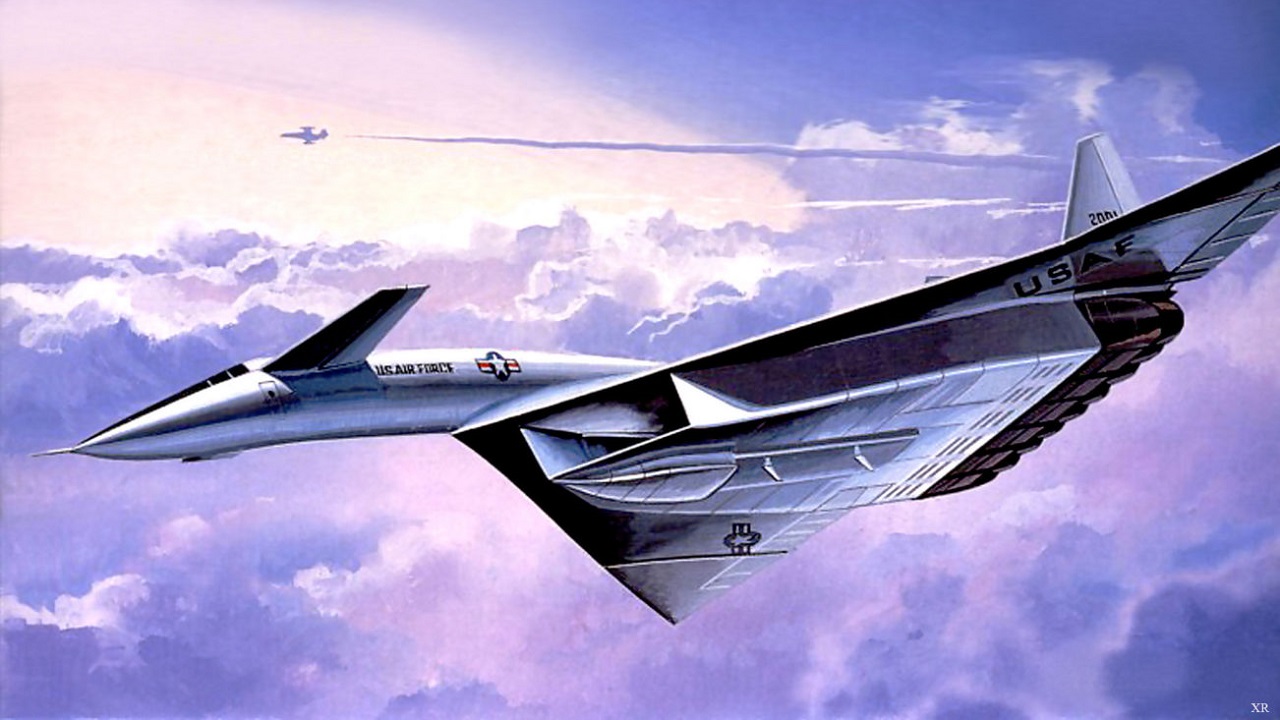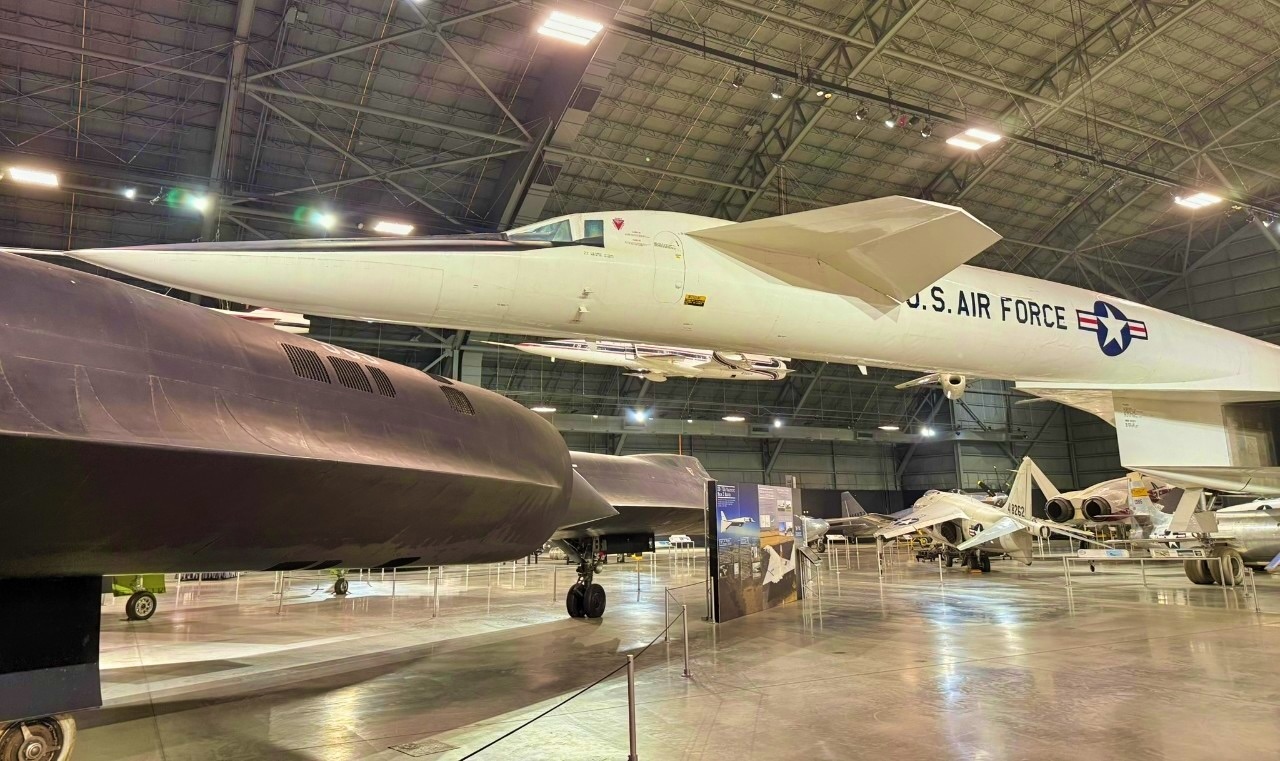Key Points and Summary – The North American XB-70 Valkyrie embodied a once-dominant creed: outrun defenses at Mach 3 and 70,000 feet.
-The prototype proved the physics—compression-lift wingtips, hot-structure skins, 172,000 lb of thrust—and matched B-52 payloads at triple the speed. But SAMs, ICBMs and cost killed the program; a 1966 midair sealed its fate. Its real legacy was data that fed SR-71, B-1, and modern high-temp design—plus a caution: raw performance doesn’t equal survivability.

XB-70. Image Credit: Creative Commons.

XB-70. Image Credit: Creative Commons
-Today’s debate echoes that lesson as the U.S. bets on stealth bombers and hypersonics. The smart hedge is massed, cheap, autonomous systems that persist, adapt, and complicate an enemy’s kill chain.
-XB-70 Visit: National Security Journal visited the XB-70 bomber located at the U.S. Air Force Museum. We have included photos from that visit.
XB-70: When Speed Wasn’t Enough
In May 2024, the North American XB-70 Valkyrie – the only surviving example of the U.S. Air Force’s Mach 3 strategic bomber project – was towed out of the fourth hangar at the National Museum of the United States Air Force in Dayton, Ohio, for restoration and the reshuffling of exhibits.
The massive six-engine aircraft’s movement was insignificant, amounting to little more than a reshuffle.
Still, its reappearance in the news media serves as a pretty timely reminder of how far bomber design philosophy has changed over the years.
The impressive XB-70 – which is easily one of the most remarkable sights in the museum – represents an era when speed and altitude were seen as the ultimate forms of survivability.
Today, however, the U.S. Air Force relies more heavily on stealth, range, and networked coordination.
Not to mention automation and drone capabilities.
But looking back at the Valkyrie’s short life helps explain precisely why the U.S. Air Force changed direction, and how debates about the future of American air power are shaping up as hypersonic systems become central to modern planning.
National Security Journal Visits the XB-70 Bomber

XB-70 in Dayton, Ohio Air Force Museum. Image Credit: National Security Journal.

XB-70 Up Close @ U.S. Air Force Museum. Image Credit: Harry J. Kazianis/National Security Journal.

XB-70 Is a Massive Bomber. Image Credit: National Security Journal.

XB-70 Bomber from National Security Journal. Taken at the USAF Museum in Dayton, Ohio, on 7/19/2025.
The Race to Mach 3
The XB-70 is a prototype of the planned B-70 nuclear bomber—a striking design that earned its place in the history books.
North American Aviation developed it in the late 1950s to outrun Soviet defenses and deliver nuclear weapons deep into enemy territory.
Perhaps most notably, aside from its striking design with enormous wings, it was designed to cruise at Mach 3 and at altitudes well above 70,000 ft.
The aircraft’s six General Electric YJ93 turbojet engines also generated more than 172,000 lb of thrust.
Among the key innovations of the time were its folding wingtips, designed to generate additional compression lift at high speeds, and a stainless-steel honeycomb structure that could withstand the heat generated at Mach 3.
The aircraft could also carry a payload of up to 50,000 lb – roughly equal to that of the B-52 Stratofortress – but at three times the speed.
The Valkyrie’s performance was completely unmatched at the time.
In 1965, it reached Mach 3.08 at 74,000ft, which was faster and higher than any bomber before or since.
So, why was it retired? Largely: timing. The aircraft arrived at a time when speed was no longer enough to guarantee survivability.
Why the XB-70 Program Collapsed
By the early 1960s, the strategic environment had changed. Soviet surface-to-air missiles like the SA-2 Guideline might make high-altitude bombers vulnerable for the first time.
Intercontinental ballistic missiles also provided faster, cheaper nuclear delivery with no risk to the crew.
In response to the changing threat environment, Secretary of Defense Robert McNamara canceled the production version in 1961, approving only two prototypes for research flights.
Cost also came into play.
Each aircraft cost roughly $700 million in today’s dollars, and total program costs were projected to exceed $10 billion if 210 aircraft had been built as planned.
The end of the program officially arrived in June 1966 when one prototype collided mid-air with an F-104 Starfighter during a publicity flight, killing two crew members.
Only one Valkyrie survived, and by the late 1960s, the Air Force had fully adapted to low-level penetration tactics, and then later, stealth technology as radar and missile systems continued to improve.
A Necessary Flop?
Although the aircraft never actually entered service, the design was instructive in multiple ways.
The XB-70 generated important aerodynamic and materials data that was later used in the development of the SR-71 Blackbird and B-1B Lancer programs.
The Valkyrie also validated theories of supersonic airflow and high-temperature stress loads, which became foundational to later designs.
The aircraft was built to withstand incredible speeds and, subsequently, incredible heat – something that modern aircraft designs have built on.
The XB-70 also demonstrated that performance alone cannot define an aircraft’s value. This was one of the highest-performing aircraft ever made, and it achieved everything its designers promised—but by the time those designers could prove what it was capable of, the mission demands had changed entirely.
As soon as radar coverage, missile range, and computing power improved, the need for a Mach 3 bomber disappeared virtually overnight.
The Valkyrie failed, yes—but it succeeded in instructing future platforms.
It didn’t arrive too soon, as is the age-old excuse. It wasn’t “ahead of its time.” In fact, it was too late for its own war.
The aircraft certainly proved what engineers could achieve, but not what the Air Force needed at the time.
The lesson that raw performance isn’t always the answer is relevant today, too.
It’s a lesson worth remembering as the United States invests in stealth bombers and hypersonic weapons: yes, these assets are necessary, but are we also missing a trick?
And could that trick be cheap, autonomous systems?
About the Author:
Jack Buckby is a British author, counter-extremism researcher, and journalist based in New York. Reporting on the U.K., Europe, and the U.S., he works to analyze and understand left-wing and right-wing radicalization, and reports on Western governments’ approaches to the pressing issues of today. His books and research papers explore these themes and propose pragmatic solutions to our increasingly polarized society. His latest book is The Truth Teller: RFK Jr. and the Case for a Post-Partisan Presidency.
More Military
‘Skipper, We Have Been Hit’: Tiny Nuclear Sub ‘Sank’ $4.5 Billion U.S. Navy Aircraft Carrier
China’s Military ‘Quantum Leap’ Doesn’t Add Up
Russia’s Air Defenses Are Springing Leaks—and Ukraine Is Exploiting Them
Japan Might Be Ready to Fight for Taiwan. Would America Do the Same?










